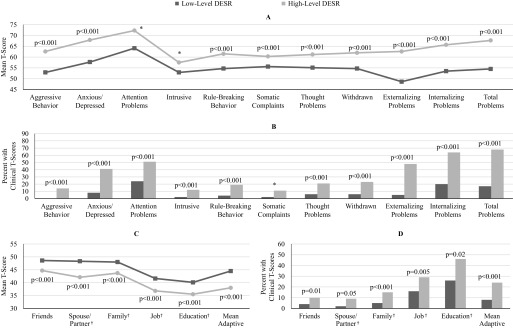Figure 3.
Adult self-report (ASR) scores in subjects with high (total Barkley ED score ≥ 8) and low (total Barkley ED score < 8) DESR scores. (A) ASR Clinical and Composite Scales; (B) subjects with T-scores in the Clinical Range on the ASR Clinical and Composite Subscales; (C) ASR Adaptive Functioning Scales; and (D) subjects with T-scores in the clinical range. †Sample sizes vary. Spouse/partner: low-level: N = 115, high-level: N = 79; family: low-level: N = 245, high-level: N = 188; job: low-level: N = 200, high-level: N = 150; education: low-level: N = 76, high-level: N = 68. Patients with high-level DESR were significantly more impaired than those with low-level DESR. *Significant interaction between DESR level and medication status (all three p-values <0.05). Stratified analyses revealed significantly higher T-scores on the attention problems and intrusive subscales in those with high-level DESR among both medicated and unmedicated patients. They also revealed a significantly greater percentage of scores in the clinical range on the somatic complaints subscale in those with high-level DESR among the medicated patients but not the unmedicated patients.

